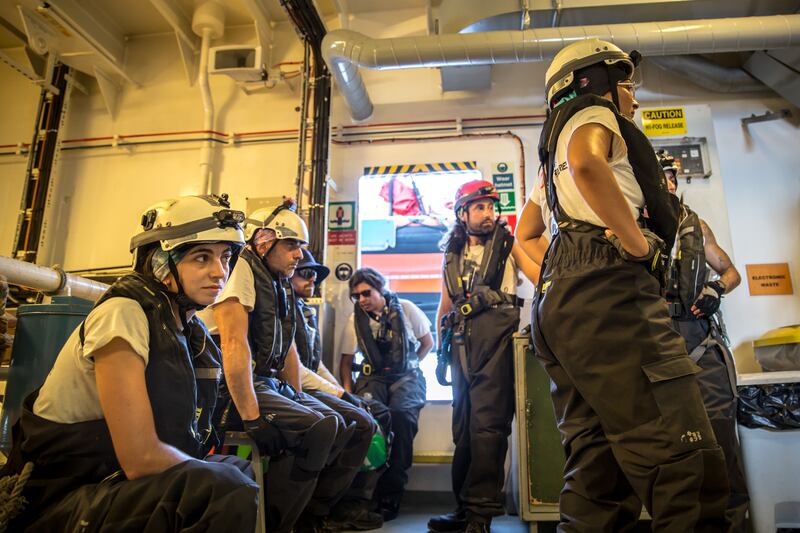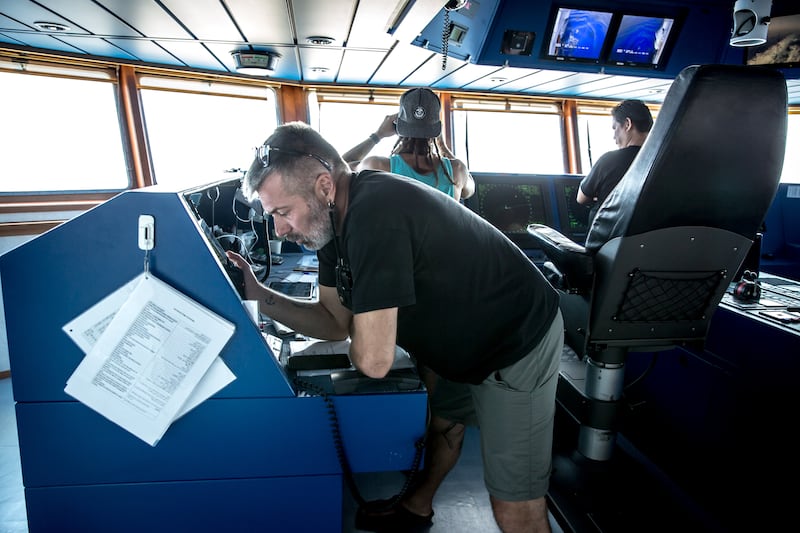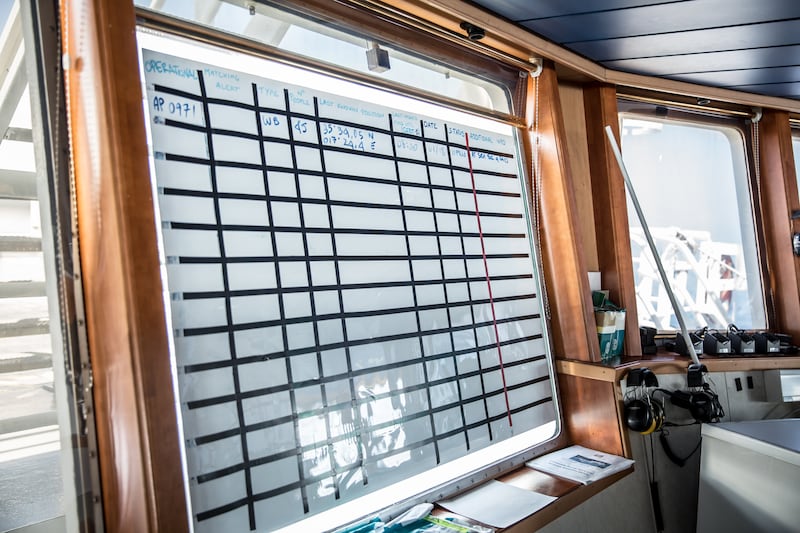The Libyan vessel moved at twice the speed of the Geo Barents rescue ship. The Geo Barents – operated by medical charity MSF – risked detention if the Libyans complained about interference. So the crew sat and waited, hoping they could still carry out a rescue.
A call came through saying the Libyans had arrived on the scene; desperate refugees and migrants began jumping from their overcrowded boat into the water to escape them – and still the crew waited. Until, eventually, the MSF search and rescue was called off and the case declared “closed”.
In a debrief, search and rescue team leader Riccardo Gatti asked his dejected team if they were okay. “This is part of the job,” he told them. “This is the environment ... as sad as it is ... unfortunately there are moments where we cannot rescue the people.”
From the bridge, through binoculars, the Libyan vessel was still visible. Sea Bird – an NGO-operated search and rescue plane – identified it as the Libyan patrol boat P662 Murzuq, one of two “Corrubia class” naval vessels donated by Italy in 2023. The Libyans aboard those vessels had previously been accused of threatening NGO crews, including by firing into the water in front of them, forcing them to abandon rescues.

Interceptions
As record numbers of people globally continue to be forcibly displaced, or seek new opportunities outside their birth countries, the central Mediterranean remains a point of contention for how to deal with them. While European Union policies attempt to prevent people from reaching European territory, civil society organisations try to bring them to safety.
[ Rescue ship tries to save minds as well as bodies on the MediterraneanOpens in new window ]
More than 24,000 people have died or gone missing in the central Mediterranean in the last decade, while more than 51,000 have arrived in Italy by sea so far this year. From January to October 5th, 2024, figures from the International Organisation for Migration showed that 18,065 people were intercepted and forced to go back to Libya. More than 147,000 people have been caught in this manner since 2017, when the EU pledged tens of millions of euro to support the Libyan coastguard to carry out interceptions. Those caught are often locked up in Libyan militia-run detention centres with no charge or trial, as part of an abusive system where UN evidence suggests crimes against humanity are taking place.
Tunisia has also received EU money to carry out interceptions. According to estimates by Alarm Phone, which receives distress calls from people at sea, another 30,000 people were estimated to have been returned to the north African country in the first six months of 2024. Kais Saied, Tunisia’s recently re-elected autocratic president, has been courted by European politicians while inciting a backlash against black Africans. Tunisian security forces have been condemned for abandoning them in the desert without food or water.
Those trying to cross the Mediterranean Sea are fleeing crises including wars, dictatorships, persecution and crushing poverty across Africa, Asia and the Middle East. Many have passed through multiple other countries where they are abused and exploited. They hope to find safety in Europe.
One aspect of the EU’s efforts to stop them is its use of Israeli drones. As far back as 2009, Human Rights Watch described how drones from the Heron series used by Israel have killed Palestinian civilians in Gaza. In 2020, the Guardian reported on a €100 million deal between the EU, Airbus and two Israeli companies for the use of drones in the Mediterranean. The day Gatti consoled his disappointed crew, an unmanned Israeli Heron surveillance drone was on patrol – it flew five out of seven days that week.
“Israeli drones are essentially ones that have been tested over Gaza for many years,” said Antony Loewenstein, author of The Palestine Laboratory: How Israel Exports the Technology of Occupation Around the World, which describes how this technology was reappropriated by the EU in the Mediterranean. “Israel and the EU are very close partners,” he said. “There’s huge amounts of defence relationships, huge amounts of weapons being sold.”
[ Israeli arms companies can bid for Irish drones contractOpens in new window ]
Despite the ongoing assault in Gaza, where more than 41,000 Gazans have been killed, and the more recent escalated Israeli air strike campaign which has displaced more than one fifth of Lebanon’s population, “there’s a willing disconnect between the reality of European arms companies selling weapons to worsen various global conflicts, and how huge amounts of individuals are fleeing those conflicts and trying to get into the EU,” Loewenstein said.
In 2020, the use of Israeli drones in the Mediterranean was questioned by Spanish MEPs Manu Pineda and Sira Rego – now Spain’s minister for youth and children. They asked the European Commission what criteria were used to select drone providers; whether their use is compatible with human rights policy; and whether the commission “intend[ed] to keep supporting violations of the rights of refugees in the Mediterranean and the use of military drones at the EU’s foreign borders”.
The commission responded by saying it “attaches the utmost importance to ensuring the respects of the fundamental rights of migrants and asylum seekers”.
Fabrice Leggeri, then executive director of Frontex – the European border agency – said in 2020 that it initially tested the Heron drones’ “capacity to detect and support the operational response to boats in distress, and therefore contribute to saving lives at sea”.
The subsequent tender procedures were “open on equal terms to natural or legal persons wishing to bid for the assignment”.

Aerial surveillance
In civil rescue ships such as the MSF Geo Barents, crews use apps to monitor the behaviour of Frontex aerial assets (such as planes and drones). This helps them assess if there might be emergency cases nearby. Gatti said this was particularly important in the past, when Frontex shared little or no information with NGOs, which was “really strange because sometimes we were really close to boats in distress”.
Leggeri Frontex from 2015 until he resigned in 2022, after being accused of not respecting human rights – charges he denied. This year, he was elected as an MEP for Marine Le Pen’s National Rally party in France.
Since Leggeri stood down, communication in the central Mediterranean has improved, with mayday radio alerts now sent to all ships, for example, Gatti said.
He still sees EU aerial assets out most days. .
Frontex’s equipment is much better than that used by NGOs, he said. “It’s a military technology ... we know that they have Israeli technology in terms of cameras and lenses and so on.” In contrast, his crew have “basically the normal maritime devices: radio ... binoculars, and all the open-sources platforms that are online in order to [track] vessels and aeroplanes”. From the ship’s bridge, the MSF watch crew can see just nine nautical miles in each direction – about 16.6km.
Gatti said the EU’s involvement now involves just “spotting boats and communicating the presence of those boats.” When Frontex had “maritime assets they were obligated to rescue people,” he said, and that was “linked with the responsibility to disembark them in a place of safety.” Now they are avoiding rescuing people while still carrying out surveillance from the air, he said, which “is not in line with any principle and norms regarding reducing risk and loss of life at sea”.
The EU withdrew its maritime assets from the central Mediterranean in 2019. Aerial assets do not have the same capacity or legal requirement to rescue people in distress at sea when they are discovered.
While some NGOs fly planes, an Italian government draft law suggests imposing fines of up to €10,000 on the pilots of civil society aircraft that search for refugee and migrant boats in distress, Reuters news agency recently reported. In May, Italy’s civil aviation authority barred the same search-and-rescue planes from using airports in Sicily, Pantelleria and Lampedusa. A spokesperson for Sea Watch suggested the new rules are designed to “keep secret what is happening each day in the Mediterranean”.
Felix Weiss, a former spokesperson for German NGO Sea Watch, which flies two search-and-rescue planes in the central Mediterranean, said the Heron drone has been a “game changer” for Frontex because it can stay so long in the air – 30 hours, he believed – and cover very large areas. This compares to Sea Watch’s aircraft, which can stay in the air for a maximum of eight hours.
Without Frontex’s aerial surveillance the Libyan coastguard would be “practically, completely blindfolded,” he said.

Fundamental rights
With migration becoming a hot-button political topic across Europe, Frontex’s budget has ballooned to €922 million for 2024.
Jonas Grimheden joined the agency as its fundamental rights officer in 2021. Speaking on Microsoft Teams from its Warsaw headquarters, he said the EU’s use of aerial surveillance in the central Mediterranean to support Libyan coastguard interceptions is a “complicated question, complicated situation, [there are] tragic events ... Every few hours there’s someone drowning, dying.”
He has a staff of about 70 people, and said his fundamental rights team can go into the “control room” – where drone footage is visible – to monitor what Frontex is doing at any time. However, “we have the dilemma with Frontex having very limited powers. Yes, we do the air surveillance but the member states have more or less all the search-and-rescue capacity, and also, in fairness, they cannot cover search and rescue for the whole Mediterranean.”
He perceives the situation as a “dilemma” – should they not alert the Libyans about new boats, because they want the people on board to make it to European waters? “That would be probably better for the migrants, for sure, better for fundamental rights, but highly problematic if they drown. If I had to take that decision I would for sure say the first available [people] who can rescue them [should]. If the boat looks fragile enough, I would say, you go for it. If that’s the Libyans, well then in this case, so be it.”
Regarding the EU’s use of Israeli drones, Grimheden said: “I don’t know who has produced what.” He said where technology or equipment is procured is “not the biggest issue” unless the country is on an EU blacklist, when his team could push for it not to be used. “But again, we have enough problems to work on ... and I’m not saying that this is a luxury problem. But ... of course it is less acute ...”
- Sign up for push alerts and have the best news, analysis and comment delivered directly to your phone
- Find The Irish Times on WhatsApp and stay up to date
- Our In The News podcast is now published daily – Find the latest episode here





















